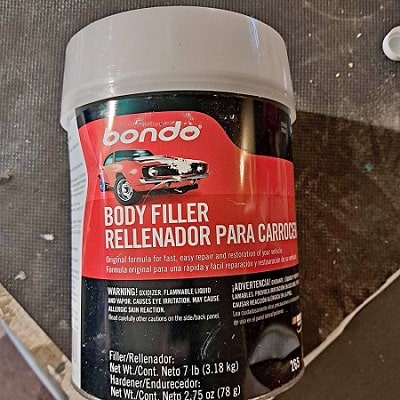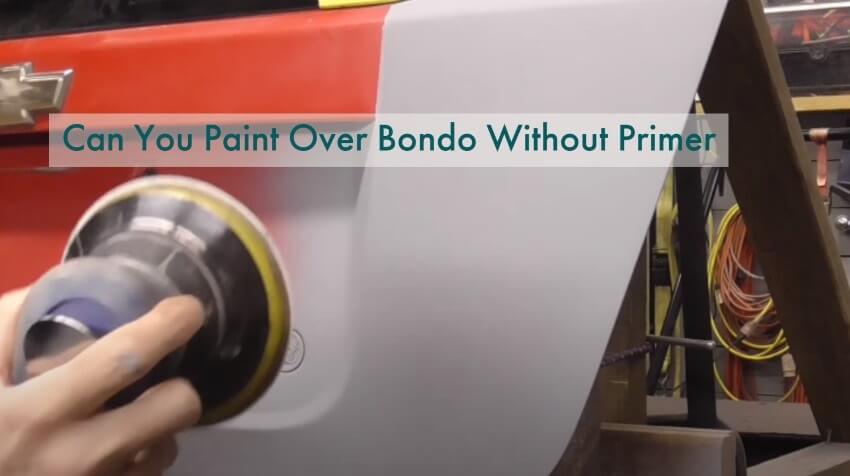Bondo is widely used by DIY enthusiasts and professionals alike to achieve a smooth and even surface before painting a car. And primer improves the adhesion of the paint to the surface.
Now the question is, can you paint over Bondo without primer? Though you can paint over the Bondo without Primer, it is not recommended. Primer creates a smooth surface for the paint to adhere to, preventing peeling and cracking.
If you’re planning on using Bondo for your auto body or household repairs, it’s important to follow the proper steps for a successful and long-lasting finish. So, read on to learn more!
What is Bondo?
Bondo is a brand name for a two-part polyester-based body filler. This is primarily used for automotive and household repairs. It is made up of resin and a hardener.

Mixing all of these ingredients together creates an amount of putty-like substance that can be used in various ways. This can be molded and shaped to repair dents, scratches, or other imperfections in surfaces, such as
- Metal
- Wood
- Fiberglass
The composition of Bondo makes it easy to apply and sand. And this is how it’s applied and dried in a gradual manner-
- The surface needs to be cleaned, sanded and primed
- Bondo is typically applied using a putty knife or spatula
- The filler is spread over the area to be repaired, using enough to fill the area completely
- The Bondo is then allowed to dry and harden, which usually takes several hours, depending on the temperature and humidity
- Once dry, the Bondo can be sanded and shaped to match the contours of the surrounding area
- After sanding, the surface should be wiped clean to remove any dust or debris
- Once the surface is clean, it can be painted over, using a suitable primer and paint for the type of surface being repaired
The Importance of Primer
Primer is used before painting to prepare the surface by providing a consistent base coat that improves the adhesion of the paint to the surface.
The purpose of using a primer is to create a smooth, uniform surface. It will allow the paint to adhere properly and provide a more even finish.
Using primer has several benefits, including
- Better coverage
- Increased durability of the painted surface
Primer also helps seal the surface, preventing moisture or other contaminants from damaging or affecting the paint.
Using a primer is recommended for best results when painting any surface, whether the surface is new, damaged, or has been previously painted.
Moreover, it’s particularly important when applying a powder coat over Bondo or any other type of body filler.
When you do not use primer, your painted surface may not have an even finish, might have poor adhesion, or might not be as durable as it should be.
Can You Paint Over Bondo Without Primer?
Yes. You can paint over Bondo without primer, but it is generally not recommended.
Primer provides a suitable surface for the paint to adhere to and helps prevent the Bondo from absorbing moisture. Therefore, applying a coat of primer before painting over Bondo is generally a better option for a more durable and long-lasting finish.
Here are some possible outcomes of painting over Bondo without primer.
- Poor sticking of the paint to the Bondo surface
- An uneven finish, resulting in visible bumps and rough spots
- Peeling of the paint over time, especially in areas with high moisture or temperature changes
- Inability to properly bond the paint to the surface, resulting in a lack of durability
- Increased risk of damage to the Bondo surface, which may require additional repairs and repainting
- Reduced quality and longevity of the paint job, leading to the need for more frequent touch-ups or re-painting
- Increased time and cost of painting, as the need for additional repairs and repainting can be time-consuming and costly
- Reduced aesthetic appeal of the paint job due to visible imperfections and lack of durability
However, there may be some exceptions or situations where painting over Bondo without primer is possible.
For example, if the Bondo is sanded, applied to a smooth surface, and fully cured. Here, light scuffing of the surface with fine-grit sandpaper may be sufficient to promote adhesion. But it is still best to use a primer to ensure a durable and long-lasting finish.
How to Paint Bondo with Primer?
Here are the proper steps to paint Bondo with primer:
- Step 1: Clean the Bondo surface thoroughly with soap and water, then dry it with a clean cloth.
- Step 2: Sand the Bondo surface with 220-grit sandpaper until it’s smooth and even.
- Step 3: Wipe off the Bondo dust with a tack cloth.
- Step 4: Apply an automotive or epoxy primer to the Bondo surface, following the manufacturer’s instructions.
- Step 5: Let the primer dry completely, then sand the surface with 400-grit sandpaper again until it’s smooth and even.
- Step 6: Wipe off the dust with a tack cloth.
- Step 7: Paint the surface with your desired paint and let it be cured properly.
Recommended types of primer and paint for Bondo are:
- Automotive primers, such as 2K primers, adhere well to Bondo and protect against rust and other damage
- Epoxy primer is also a good choice for Bondo and provides excellent adhesion and durability
- Automotive paint comes in a variety of finishes and can be used to create a smooth, even finish over Bondo
What About Applying Bondo and Primer On Wood?
The process for painting Bondo on wood is similar to painting on other surfaces. You only need to be careful about applying a wood primer or a bonding primer that is compatible with wood. Follow the manufacturer’s instructions in this regard.
Likewise, when it comes to painting Bondo on wood, it’s important to choose a paint that is suitable for wood. Latex or oil-based paints are commonly used for wood surfaces.
Tips For Achieving A Smooth Finish When Painting Bondo
Here are some useful tips that can be handy while painting Bondo.
- Use a high-quality paintbrush or spray gun to apply the primer and paint
- Apply thin, even coats of primer and paint to avoid drips and uneven surfaces
- Allow each coat to dry completely before applying the next coat
- Sand the surface between coats to create a smooth, even finish
- Take your time and be patient, as rushing the process can lead to uneven results
Final Thoughts
While it may be possible to paint over Bondo without primer in certain situations, it is not recommended. That’s because this can lead to poor adhesion, an uneven finish, and peeling.
So, to achieve a smooth and long-lasting finish, it is best to follow the proper steps and use primer when painting over Bondo. Moreover, safety precautions should be taken when handling and applying it. Following these guidelines can help ensure that Bondo repairs are safe, effective, and long-lasting.
Related Posts
Can You Powder Coat An Engine Block | All Facts Explained
Can You Powder Coat Chrome Wheels
Powder Coat Your Aluminum Wheels Today – Say Goodbye to Chipped Paint


